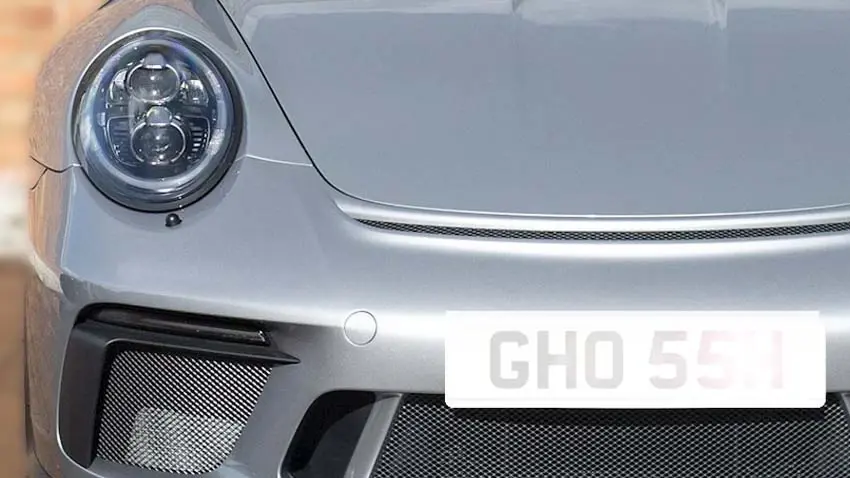
You may have heard of "ghost plates": they've been a hot topic with online and broadcast media in both the UK and the USA. However, many people, including journalists, seem unsure exactly what they are talking about when they use the term.
So, what are ghost plates?
Unhelpfully, the term gets applied to a number of things.
It has become a blanket term for any plates that have been altered or obscured with the intention of hiding a vehicle's true registration number.
Amongst the measures that have been employed are:
- covering the plate with a translucent gel, or a sheet of translucent plastic, intended to make the plate unreadable by ANPR and other enforcement cameras;
- applying a spray or paint that alters the plate's reflective properties;
- altering the appearance of characters with black tape or strategically placed black bolts;
- physically obscuring the number plate by deliberately covering it in mud, or sticking dead leaves (real or artificial) over the characters.
There are also number plates available that have actually been manufactured with the intention that they should be unreadable by cameras. Some of these are treated or covered to make them reflect light in a highly directional way. This means that a person or camera at the same level as the plate would be able to read it normally, while a view from above sees just a blank rectangle where the plate should be. As most traffic cameras are mounted several metres above the vehicles they observe, drivers using such gimmicks are able to misbehave without fear of being identified by photos or video.
Other plates present different reflective qualities depending on whether the instrument recording them uses visible light or infrared. What look like normal number plate characters to the naked eye may be almost invisible to infrared cameras.
In a wider sense, any number plate that has been altered or obscured by any means may be, and often has been, referred to as a ghost plate.
Born in the USA
The term ghost plates seems to have originated in the USA. It's difficult to pin down which usage came first, but many early media reports using the term were discussing the misuse of paper "temporary tags" that US drivers sometimes display until their metal plates arrive. A number of cities and states in the USA have reportedly experienced widespread abuse of the temporary tag system.
Some drivers use the tags long after they should have installed proper plates because they can quickly and easily remove the tags from their position stuck inside the car's windshield, commit speeding offences or toll evasion etc, and then replace the tag. There is also a problem with fake tags that show the wrong license plate number.
However, as in the UK, the term has come to be applied to a wide range of measures aimed at evading detection and identification by cameras. Many of the same techniques used in Britain are used in America too, with one notable addition.
American license plate characters are generally stamped into the metal plates and then painted. One way to make it harder for cameras to read these stamped plates is to scrape paint off the characters.
So, on both sides of the Atlantic, the ghost plates label can mean any of several things.
The British picture
As if there weren't already a diverse enough collection of things to cram together under the ghost plates lexical umbrella, there's more.
What we in the UK usually refer to as cloned number plates (plates bearing registration numbers illegally copied from other cars in order to hide a vehicle's real identity) are also getting lumped into the ghost plates category, despite "cloned plates" already being well established as a more helpfully descriptive term.
West Bromwich's Labour MP Sarah Coombes has laid down a Ten Minute Rule Bill in Parliament. The bill, co-sponsored by Labour MP Paul Waugh, proposes that offenders using ghost plates should receive a fine of £1000 and at least six penalty points. Other measures suggested include vehicle seizure as a deterrent.
Ms Coombes seems fairly clear what she and her bill mean by ghost plates, and that it refers to those plates which are manufactured or treated to make their characters unreadable by cameras.
The media's contribution
Despite some clarity in Sarah Coombes's campaign, due to indiscriminate use of the term, it's sometimes impossible to be sure exactly what is being discussed without further explanation or context, so the last thing we need is false or confused information dropped carelessly into the mix.
The media: "Hold our beer".
In December 2024, a news article on the GB News website, reported a warning from "experts" about...
[...] rogue drivers using "ghost plates" and other deceptive tactics to evade speed cameras and traffic enforcement across the UK. [...] So-called "ghost plates", also known as 3D or 4D number plates, are specifically designed to reflect light in ways that confuse camera detection systems.
Nonsense.
Let's be clear that the products widely known to the public and to the number plates industry as 3D and 4D number plates are not designed to "reflect light in ways that confuse camera detection systems". They are simply a perfectly legal decorative alternative to flat printed characters.
The legality of 3D and 4D number plates has long been another area of great confusion and uncertainty. Regtransfers has covered the subject in depth on a number of occasions, so we won't make this already-overlong post any longer by including all the details here. Suffice to say that, 3D and 4D number plates per se are not currently illegal to use on UK roads.
In a letter of clarification to the British Numberplate Manufacturers' Association, DVLA said:
[...] Neither the current or new British Standards for retroreflective number plates explicitly state that number plates with raised characters, including "3D" gel and the newer so-called "4D" number plates where the characters have been attached to the plate, are not permitted. Where such characters are being used, the entire number plate must still be able to fully comply with both the British Standard and the legal requirements.
Most 3D gel and 4D number plates do, indeed, comply with the British Standard (BS AU 145e) governing number plates and the further legal requirements.
We must point out that GB News was by no means the only peddler of this misinformation: similar nonsense was published on the websites of The Mirror, The Express and other national and local news websites.
One last thing (we promise)
If they hadn't reported so carelessly and inaccurately, we might have forgiven the media for being confused themselves. There is yet another water-muddying factor we should mention if we're trying to be thorough.
There are a number of styles of acrylic number plates being marketed as "Ghost Plates" as their trademarks or product descriptions. We're not talking about dodgy, camera-defeating number plates, but about a modest variation on the normal 4D plates and 3D gel plates. (We'll distinguish these from the other kind discussed above by styling them "Ghost Plates" with initial capitals.)
Generally speaking, where these Ghost Plates differ from normal 4D plates is that their characters feature either a raised ridge or border around the edge of each character, or the opposite, a recessed or rebated border. Either way, a kind of physical step is present.
These plates may be legal in some cases and illegal in others. So far as we are aware, the question has not yet been tested and settled.
We can envisage some Ghost Plates possibly being legal if, for example, the "stepped" effect does not affect readability of the plate's characters and if the plate meets all the requirements of BS AU 145e and the regulations. However, at least one variant we have seen advertised offers the option for the characters' raised portion to be of a grey that contrasts with the black of the rest of the character. We are confident that these shaded characters would not meet the legal requirements, even though the product is advertised as road-legal.
In the same letter we quoted earlier, DVLA said:
It is already a requirement under the current British Standard that the entire surface of the characters of the registration number must be black and this has carried over to the new standard with the important difference that different shades of black can no longer be utilised to create highlighting or 3D effects. This requirement for the characters being black also includes the sides of the characters.
So, it's probably safest to say that the legality jury is still out on this last kind of Ghost Plate as there are several variations on the theme. One thing is certain though: these are not the products you're looking for if you're daft enough to put your trust in anti-camera number plates.
